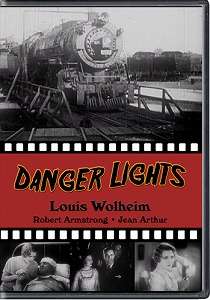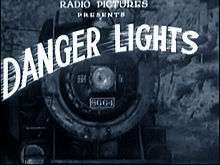Danger Lights
Danger Lights is a 1930 American Pre-Code drama film, directed by George B. Seitz, from a screenplay by James Ashmore Creelman. It stars Louis Wolheim, Robert Armstrong, and Jean Arthur.
| Danger Lights | |
|---|---|
 Video cover | |
| Directed by | George B. Seitz |
| Produced by | William LeBaron Myles Connolly (assoc.) |
| Written by | James Ashmore Creelman |
| Starring | Louis Wolheim Robert Armstrong Jean Arthur |
| Cinematography | Karl Struss John W. Boyle |
| Edited by | Archie F. Marshek |
| Distributed by | RKO Pictures |
Release date | |
Running time | 74 minutes (original) 55 minutes (television edit) |
| Country | United States |
| Language | English |
The plot concerns railroading on the Chicago, Milwaukee, St. Paul and Pacific Railroad (Milwaukee Road), and the movie was largely filmed along that railroad's lines in Montana. The railway yard in Miles City, Montana was a primary setting, while rural scenes were shot along the railway line through Sixteen Mile Canyon, Montana. Additional footage was shot in Chicago, Illinois (where the Milwaukee Road was headquartered until 1986 when it went out of business.) The film was the first ever shot in the new Spoor-Berggren Natural Vision Process.
Plot

Louis Wolheim plays the boss of the railroad yard in Miles City, Montana. The film opens with a landslide across the tracks in Montana, and a repair crew is dispatched to clear the tracks. Several hobos are lounging nearby and are put to work helping the repair crew. One of the hobos, played by Robert Armstrong, is discovered to have been a former railroad engineer who lost his job due to insubordination. He is given a new job for the railroad by the yard boss, but quickly falls in love with the boss's fiancée, played by Jean Arthur.
Jealousy grows between the two over the affections of Arthur with both of them attempting to win her in marriage. Things come to a head during a fight in the railroad yard between the two, during which Wolheim is hit by a train and injured. To save his life, Armstrong must transport him in record time to Chicago for surgery.
Cast
- Louis Wolheim as Dan Thorn
- Robert Armstrong as Larry Doyle
- Jean Arthur as Mary Ryan
- Hugh Herbert as Professor
- Frank Sheridan as Ed Ryan
- Robert Edeson as Tom Johnson
- Alan Roscoe as Jim
- William P. Burt as Chief Dispatcher
- James Farley as Joe Geraghty
(Cast list as per AFI database)[1]
Notes
Danger Lights was filmed during a period when some movie studios were experimenting with various widescreen film formats. As part of this trend, two versions of the film were created. One used standard 35mm film and Academy ratio, the other used an experimental 65mm widescreen format at a 2:1 aspect ratio. This latter process was called "Natural Vision" and was invented by film pioneers George Kirke Spoor and P. John Berggren. The Natural Vision print of the film was reportedly screened at only two theaters (the only two with the equipment necessary to show the film), the State Lake Theater in Chicago and the Mayfair Theater in New York, and no copies of it are known to exist today. Danger Lights would be the only film created using this process, and the entire effort to move to wide screen would be shelved for several decades due to the increased costs of both production and presentation.[1][2][3]
Historically significant footage
Danger Lights features rare footage of a tug of war between two steam locomotives, actual documentary footage of the activities in the Miles City yard, and what is believed to be the only motion picture footage of a dynamometer car from the steam railroad era in the USA. Similar footage may have existed in MGM's Thunder (1929), with Lon Chaney but that film now only exist in fragments making it partly a lost film.[4]
In 1958, the film entered the public domain in the United States because the claimants did not renew its copyright registration in the 28th year after publication.[5]
Danger Lights was edited down to 55 minutes for television broadcast; this version is freely available for download. In 2009 Alpha Video released the original 74 minute version[1] on DVD.[6][7]
References
- "Danger Lights: Detail View". American Film Institute. Retrieved April 16, 2014.
- Coles, David (March 2001). "Magnified Grandeur". The 70mm Newsletter. Retrieved August 6, 2014.
- Jewell, Richard B.; Harbin, Vernon (1982). The RKO Story. New York: Arlington House. p. 30. ISBN 0-517-546566.
- Thunder (1929) - LouChaney.org
- Pierce, David (June 2007). "Forgotten Faces: Why Some of Our Cinema Heritage Is Part of the Public Domain". Film History: An International Journal. 19 (2): 125–43. doi:10.2979/FIL.2007.19.2.125. ISSN 0892-2160. JSTOR 25165419. OCLC 15122313. See Note #60, pg. 143
- DVD Empire
- Alpha Video Announces Its April '09 Roster|Blogcritics
External links
- Official website
- Danger Lights on IMDb
- Danger Lights at AllMovie
- Magnified Grandeur - The Big Screen, 1926-31, David Coles, 2001
- Danger Lights (edited television version) at the Internet Archive
- Danger Lights(edited television version) on YouTube
- Colorized version also on YouTube
- TCM.com